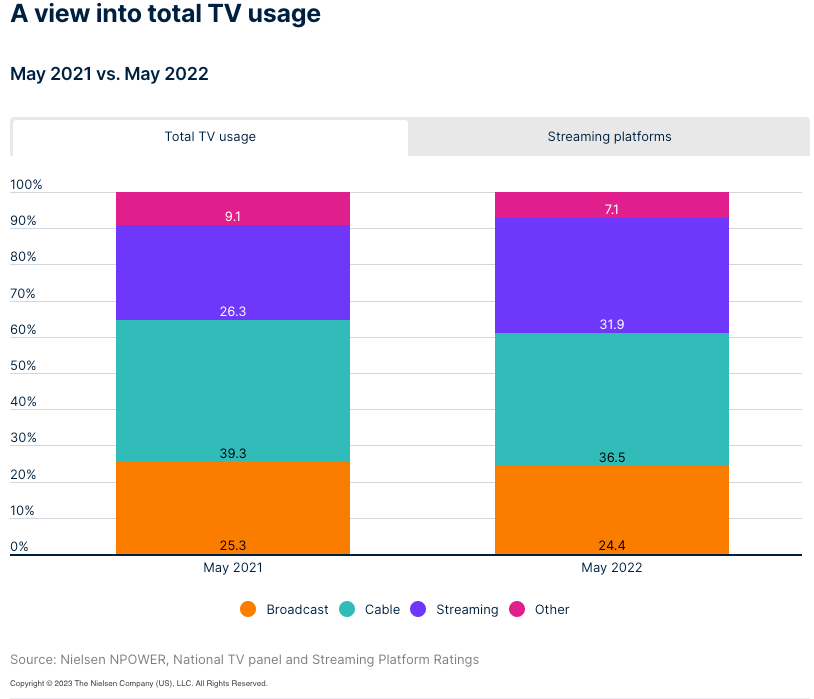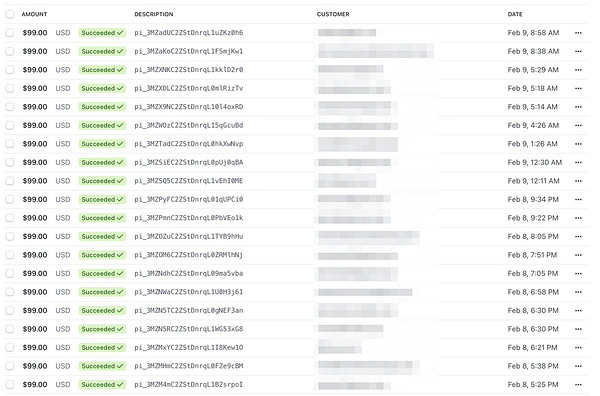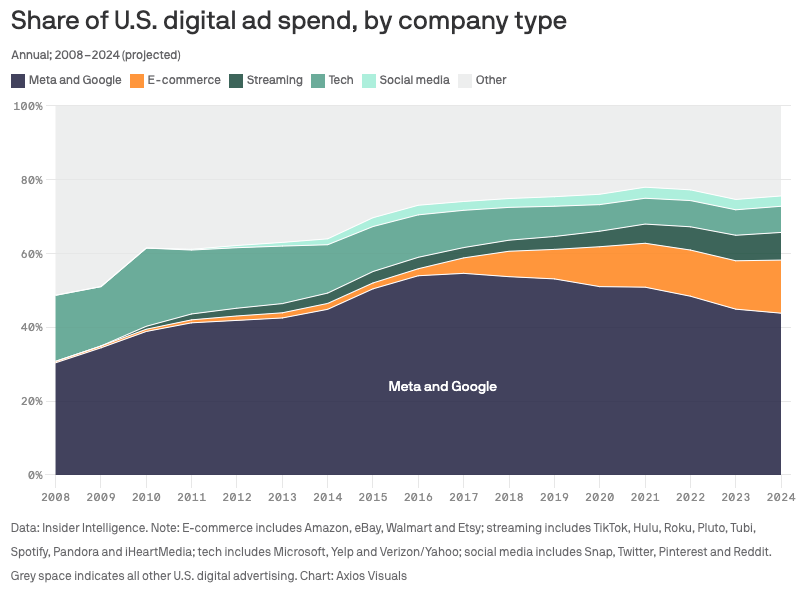Organic discovery in 2024 and beyond
With large language models (LLMs), ecommerce searches, video streaming and individual content creators fundamentally altering online advertising, how will new B2C companies drive growth next year?
Predicting the future is a messy, yet fun activity. It is a critical one for people in growth functions (like me) because the ecosystem itself keeps evolving rapidly. One way to visualise this is via the graph below on how advertisers have spent online in the US. The critical observation here is that while the online ad spends have increased, they have been redistributed across multiple channels and there are no dominant players or advertising formats. Sidebar: the graph is just for US but it mirrors my experience globally.
The inwards looking, operational view to this graph is that at the beginning of each quarter, most growth teams submit a budget to finance saying “I” would acquire x users at the cost of $ y implying I will spend $ x*y for future profits of more than $ x*y. By the time the quarter is through, the ad market itself has moved significantly which creates two problems:
The targets still need to be met. Whether a firm is public or private, growth is an imperative.
Predicting quality of customers (and hence, future profits) is hard since channels of acquisition have changed.
Most growth teams are hence, intentionally designed to be Bayesian. Every few days, someone argues for a new hypothesis, sets up an experiment with a tiny budget to prove that the ROI is working as expected and gets more budget in the next cycle. One of my colleagues sarcastically called growth folks (i.e., me and my team) hamsters on cocaine and I can’t help laughing at the characterisation.
The all-important counterfactual: What if you don’t have any budget? Then you rely on the unpaid elements of all these attention streams. In all cases, the unpaid elements existed before the paid ones and have had more time to evolve. There are four which I’m most excited about that cover a large chunk of organic reach:
Video: People are spending nearly 1/3 of their entertainment time on video streaming platforms and watching less cable. Youtube, TikTok, Instagram now have a well established advertising system but are still figuring out the correct recipes for monetising short-form videos. Netflix, Disney, Apple etc. are gaining eyeballs but haven’t yet cracked their advertising models (yet).

Source: https://www.nielsen.com/insights/2022/streaming-usage-increases-21-in-a-year-to-now-account-for-nearly-one-third-of-total-tv-time/ Within the video ad space, I’m personally most excited about micro-influencer advertising for organic reach. There are so many brilliant examples of execution here from large brand-led campaigns (e.g., Tabasco) to digital-first celebrities leaning into their followers (e.g., Mr. Beast launching burgers) to niche content creators seamlessly integrating advertising into content (e.g., Dr. Huberman plugging athletic greens). Two sidebar comments:
It wasn’t obvious from the Axios graph but YouTube’s quarterly revenue (~$8B globally) is bigger than the entire streaming ad industry put together (emphasis: outside China). Meta doesn’t split up revenue by format so it’s hard to say how much is video but as an advertiser, I’d guess video on Facebook and Instagram is comparable to Youtube. Together, Google and Meta dominate video with players like TikTok playing catchup
Netflix is bigger than Youtube but its business model isn’t relevant for organic discovery
Ecommerce: The rise in marketshare of Amazon ads was probably caused by (not only correlated to) VC funding going to “Fulfilled by Amazon” businesses like Thrasio, SellerX, … this list is long. The core premise of investing in the domain was that like AWS for compute / storage, Amazon can create a logistics infrastructure stack which any firm can use for fast and reliable delivery. What the direct to consumer startup needs to solve is merchandising. This investing premise is horrific in terms of both unit economics and loyalty but those are not my pigs and not my farm.
Amazon Marketplace has always been the OG merchandising solution on which they conveniently layered an advertising layer to pay and increase reach. Today, this is the fastest way to launch a new direct to consumer brand while still validating if people love the product. I can create just 10 packs of an amazing dogfood, take some instagrammy pictures of a pup and we’re in business. Personal note: if things start looking up in your business, search for people in your space not haemorrhaging money (in this example, Chewy 🤔) and take inspiration from their playbook instead.Conversational search: Hype cycles in tech are nothing new but I fear the reports of Google’s death are under exaggerated. Search is the most powerful user acquisition mechanic the Internet has witnessed in the last three decades. Search queries are widely understood to be of 3 types1.
Informational: specific questions of the form, “weather in London”
Navigational: specific site searches, “BBC weather”
Commercial: trying to actually buy something “top rated running shoes for rain”
Google got _great_ at the navigational and commercial queries to dominate search. It is super impressive that a Google search of the form: “home24 lamps” returns an order of magnitude better result than actually visiting home24.de (a German home retailer) and then searching for lamps. But why did it happen? The economic incentives for this were beautifully aligned.
All of the proverbially “good” actors on the Internet running businesses which relied on users buying things were out-competing each other to create structured data that is easy to scan.
Middlemen aggregators sprung up where the markets were fractured e.g., movies, restaurants, hotels to enable better coverage. Google created its own middlemen layers such as Maps and Translation which helped this cause
Businesses also spent money to advertise on “branded” keywords with an intent to be more visible on Google’s search result real estate. This created further incentives to improve bidding optimisations and quality
Informational queries however became a giant cesspool because of misaligned incentives. Such queries, by definition either have a correct answer (== “will it rain today?” or “how do you write a regex for doing [x]?”) or where structured data (text + links) returns objectively bad answers (== “how can I make boba tea?”).
Since the only economic model available to Google and for people creating such content is to show advertising unrelated to what the user is searching for, pointless ads took over
Game theory at play pushed legitimately good content creators to share as little as possible with Google. Bad players on the other hand created pointless SEO spam. I have very fond memories of what user forums used to be. Shoutout to teambhp for Indian auto enthusiasts. Reddit, Stack Overflow and Hacker News are probably the last decent places left from that era.
Over the last few months, large language models like chatgpt have progressed beyond toy implementations and getting better everyday. I’ve personally moved a chunk of my team’s budget over to generative AI tools which we’ll keep testing. As a betting man, I would put my chips on products that realign incentives for information search by getting users to pay for high quality results. Revue had a great idea here to cover all parts of the paywalled internet under one subscription. Businesses relying on organic search for informational queries are unlikely to survive this threat. Navigational / commercial queries should largely stay unaffected in either case.Email: With the rise of the individual content creator looking for distribution, email made a surprising comeback a few years ago. Mostly an after effect of social media platforms pushing monetization hard. The rise of substack, ghost, beehiv created organic distribution for creators and only getting stronger. For instance, this newsletter reached you without me paying for it and I keep adding shameless plugs for my book on pricing (Amazon, website) to monetise. Fun fact: with both earlier iterations of this newsletter, 2 people bought the book each time so I am being paid minimum wage to write these articles. I love that sooo much :-) Also, if you want to know how bonkers this idea is, this is someone with 40K twitter followers compared to my 400:


Live long and prosper 🖖,
Ravdeep
Usual housekeeping:
This substack is free to read and will continue to be so in the foreseeable future. Please feel free to share it with friends.
In case you received this as a forward from a friend, I tip my hat to them and offer you a way to subscribe below
I wrote a book last month which I really like. If you reached here, maybe you will as well. Pricing in Ecommerce, ebook (Amazon, website for a personally signed copy)
Types of search intent: https://www.semrush.com/blog/analyze-search-intent-instantly/


